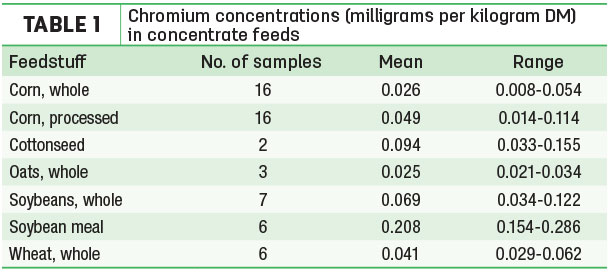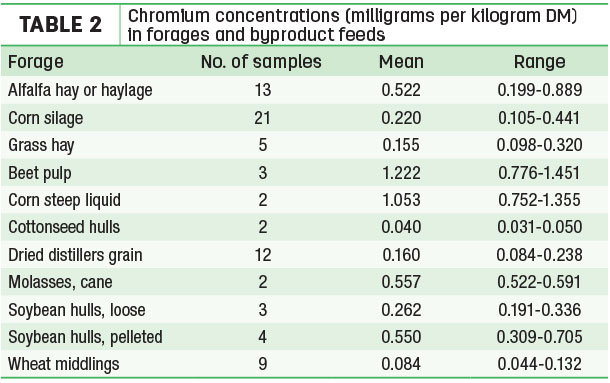Traditionally, it has been assumed practical diets fed to dairy cattle provide sufficient chromium to meet their requirements. However, research conducted over the past 20 years has shown chromium supplementation of practical diets can increase insulin sensitivity and increase cattle performance and health under certain conditions.
The uptake of glucose by muscle and adipose tissue is dependent upon insulin. If there is a lack of chromium in the body, tissues become less responsive or resistant to insulin.
The FDA issued a regulatory discretion letter in 2009 that permitted the use of chromium propionate in cattle diets. Chromium propionate is the only chromium source permitted for supplementation to cattle diets in the U.S. It can be supplemented up to 0.5 milligrams of chromium per kilogram of diet dry matter (DM).
Recent studies have shown chromium supplied from chromium propionate supplementation can increase milk production in dairy cows and enhance insulin sensitivity in cattle.
Little is known regarding chromium concentrations naturally present in practical feedstuffs. The chromium analysis of feed ingredients and total mixed diets is challenging because of the low concentration of chromium normally present in feedstuffs and problems with chromium contamination.
Recently, a study was conducted at North Carolina State University to determine chromium concentrations in feed ingredients commonly fed to dairy cattle. The study also determined the extent of variation among several feedstuffs derived from different geographic areas throughout the U.S. Feed ingredients were collected from dairy farms, feed mills, grain bins and university research farms.
Chromium concentrations in concentrate feeds
The study showed chromium concentrations in whole cereal grains were low, with average values ranging from 0.025 milligrams per kilogram of DM for oats to 0.041 milligrams per kilogram DM for wheat (Table 1).
 Processed (cracked or flaked) corn samples received and ground through a stainless steel screen had chromium concentrations almost twice as high as those in whole corn samples. Whole soybeans and cottonseed had slightly greater chromium concentrations than cereal grains.
Processed (cracked or flaked) corn samples received and ground through a stainless steel screen had chromium concentrations almost twice as high as those in whole corn samples. Whole soybeans and cottonseed had slightly greater chromium concentrations than cereal grains.
Soybean meal samples contained the greatest chromium concentration of the concentrate feeds evaluated.
Chromium concentrations in forages and byproduct feeds
The chromium concentrations found in forages and byproduct feeds from the study are shown in Table 2.
 Harvested forages contained greater chromium concentrations than concentrate feeds.
Harvested forages contained greater chromium concentrations than concentrate feeds.
Alfalfa hay or haylage (0.522 milligrams of chromium per kilogram of DM) contained greater mean chromium concentrations than corn silage (0.22 milligrams of chromium per kilogram DM) and grass hay (0.155 milligrams per kilogram of DM).
Beet pulp (1.222 milligrams per kilogram of DM) and corn steep liquid (1.053 milligrams per kilogram of DM) contained the greatest chromium concentrations of the byproduct feed ingredients analyzed. The greater chromium concentrations in beet pulp may be due to greater soil contamination because beets grow underground.
With the exception of beet pulp and corn steep liquid, other byproduct feeds averaged less than 0.6 milligrams of chromium per kilogram of DM. The pelleted samples of soybean hulls had greater chromium concentrations than samples of soybean hulls received in a loose form.
The greater chromium concentrations in pelleted samples may have been due to chromium contamination during pelleting or the grinding of pelleted samples in the laboratory.
Difficulties in accurately measuring chromium in feedstuffs
Accurately measuring naturally occurring chromium in feed ingredients is difficult because chromium contamination can occur during harvest, processing, sample collection and laboratory analysis of chromium. Chromium is abundant in nature, occurring in soils, plants, water and air.
Chromium is used as a component of chrome and in chrome plating, leather tanning and the manufacture of pigments and wood preservatives.
During feed harvesting and processing, numerous opportunities exist for chromium contamination from metal contact. Soil contamination during harvesting can also contribute to the total chromium concentration in feed ingredients and feeds.
Analytical determination of chromium also represents another source of variability and error in accurately reporting chromium concentrations in feed ingredients because of the low chromium concentrations present and chromium contamination from reagents used in preparation of samples for analysis.
In conclusion, chromium concentrations in most ruminant feedstuffs are low. The chromium found in animal feed ingredients are a combination of naturally occurring chromium in feeds and the contamination chromium from soil, metal contact or both.
Chromium in soil and from metal contamination during harvest or processing is probably unavailable or has an extremely low bioavailability for utilization by cattle. Studies in humans have also indicated the bioavailability of chromium naturally found in foods is low. Chromium propionate supplementation has been shown to be a bioavailable source of chromium, based on its ability to increase insulin action.
Mean chromium concentrations in unprocessed grains are less than 0.05 milligrams per kilogram of DM. Harvested forages contained greater chromium concentrations than grains, with mean chromium concentrations ranging from 0.155 milligrams per kilogram DM for grass hay to 0.522 milligrams per kilogram for alfalfa hay or haylage.
Byproduct feed ingredients ranged from 0.04 milligrams per kilogram DM for cottonseed hulls to 1.222 milligrams per kilogram for beet pulp.
Much of the analyzed total chromium in feed ingredients appears to be due to chromium contamination from soil or metal contact during harvest and processing. This study shows the permitted concentration (0.5 milligrams of chromium per kilogram of DM) of chromium propionate that can be supplemented to cattle diets is significant with regard to total chromium intake. ![]()

-
Jerry W. Spears
- Professor Emeritus - Department of Animal Science
- North Carolina State University






